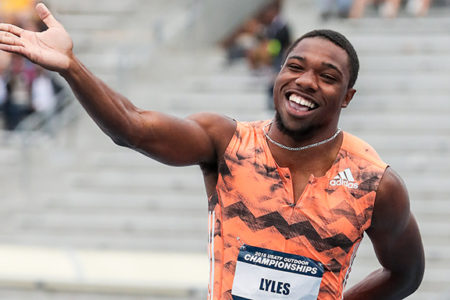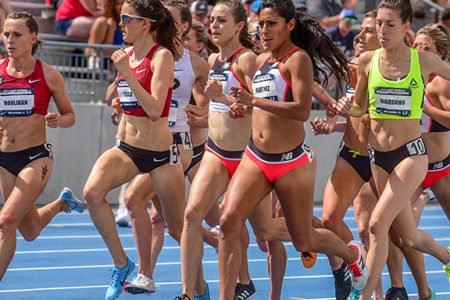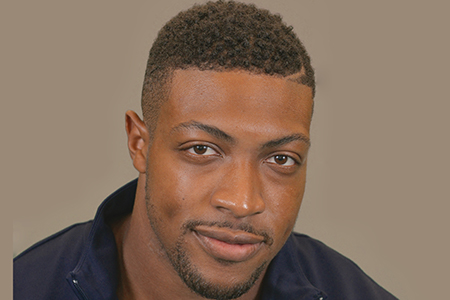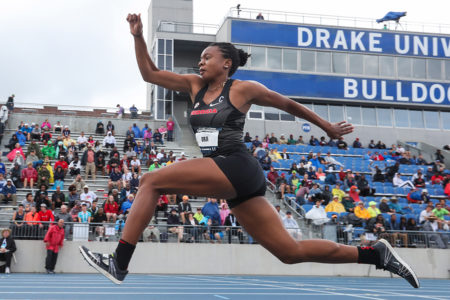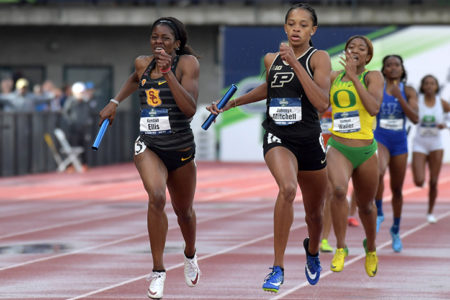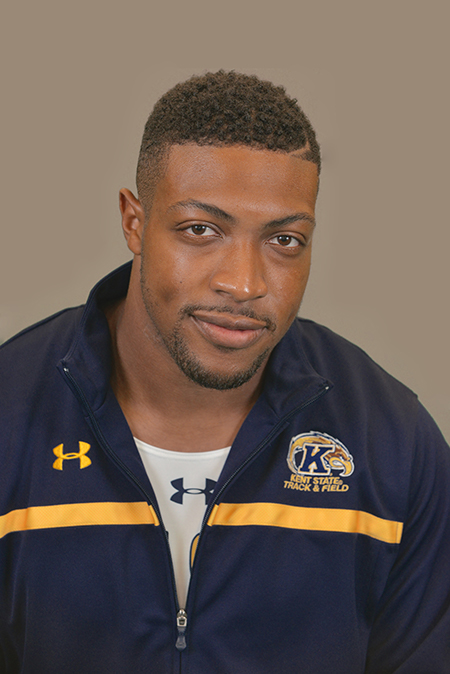
Reggie Jagers had always showed talent at throwing things, so back when he was a high school junior doing winter conditioning for football, he was naturally intrigued when he saw some of his classmates whipping a discus around. “I was always good at projectile throwing anything,” he recalls, “so I figured it wouldn’t be too hard.”
That first year at Solon High School, just outside of Cleveland, he threw in the 160s. A year later, he hit 188-6 and placed 5th in the Ohio State Meet and 2nd in the USATF Junior Olympics. Then, in his first year at Kent State, he made it to the NCAA, placing 18th and later that summer he won a bronze medal at the Pan-Am Juniors. “When I made my first U.S. team,” he says, “I realized that track would be my bread and butter. That’s why I stopped doing football.”
Jump forward a few years, and NFL scouts visiting the Kent State campus for pro day wondered why the big guy was eating birthday cake just before the 40 trials. “Aren’t you going to get ready? You’re eating cake,” one said to him.
“No man, I do track & field,” he responded.
As a junior, working with throws coach Nathan Fanger, Jagers finished 7th in the NCAA. Last year, he led until the final round, finishing 2nd with a PR 205-1 (62.51). With his move to the pro ranks, Jagers felt very confident about his chances this season. “Coming out of college every year I would get hurt towards the end of the season, recover from injury and then come back and still do pretty well at the NCAA Championships,” he says. “We knew there were good things there, but the timing of things was being affected.”
In January the 6-2/260 (1.88/118) Jagers—with a degree in sports administration (minors in business & marketing)—started working out at the Olympic Training Center in Chula Vista. “I knew that coming from Cleveland, Ohio, and moving out to Cali that I would have a lot of good weather. I’d be able to combat the southern throwers who would have a full season outside versus me who would have like 3 months outside. So I knew that this would be a breakthrough year alone just from having good weather around me and good training partners. I’ve been throwing 67–69 [220–225ft] in practice since the end of January.”
Jagers guides much of his own program, though he works with John Dagata in Chula Vista. That has been a gradual trust-building process on both sides. After a challenging start, he says, “It became a growing process of me and him learning each other and him instilling trust in me that I can get it done and that I know what I’m talking about.” He explains, “This gets all about body awareness and the proper angles and stuff like that. Americans seem to complicate it and the foreigners seem to make it simple and that’s how they throw far. We try to make like rocket science. But when you talk to any foreign coach, they say simplify.”
Jagers credits Fanger for putting him on the course to be tuned into his own training: “He instilled in me how to control my own destiny.” But he admits this season has been a struggle at times, “It’s actually been kind of a frustrating year because I basically went 65m every meet this year but three and in those meets it was a very strong right-hand wind.” And therein lies the rub. Jagers is a lefty. Most discus rings are oriented to take advantage of prevailing winds in order to provide advantageous conditions for most throwers, which generally translates to right-handed throwers. And still in all 9 of his outdoor meets to date in ’18, Jagers has surpassed his PR from the previous year.
Give a thrower like Jagers the occasional helpful wind—as happened on some of the throws in Des Moines, and you might see something even better. Discus fans at nationals not only saw him move to No. 16 ever among U.S. throwers, they also saw the farthest throw in world history for a lefty. His 225-1 (68.61) added a foot to the old best of 224-1 (68.30) set by Sweden’s Stefan Fernholm in ’87. Now there are just 47 right-handers between Jagers and the ultimate longest throw.
“That record was definitely good to break,” says Jagers. “Those guys they were so great, those were the only guys that I would watch early on as well. When people are watching me throw, it’s hard for them to see what I do wrong because I’m left-handed. Obviously if I’m my only reference, it’s hard for me to see my imperfections as well, but they’re glaring, and when you switch it over to right-handed view using applications on my phone, it has definitely helped me see the errors of my throwing.”
Given the right-handed nature of the event, Jagers may pose a bigger threat to the podium than he will to the record book. Of his USATF win, he says, “The swirling wind was definitely a good thing. When [right-handers] don’t have a good wind to their liking, they just won’t throw far because mentally they feel like without that great wind they can’t go far. And me being left-handed, I’ve been in deficit winds all my career. So I just know whenever there’s a comparable wind, equal wind or anything like that, I’m definitely going to win. I know when it’s a right-handed wind I’ve just got to throw a little bit harder to get that victory.”
He laughs and adds, “I wish there were wind legal throws in the discus—I would be No. 1 in the world for sure. It’s just crazy how much the wind can affect you. If I’m going against a good right-handed thrower in their wind and I’m still beating them, it just shows that you’ve got to be really locked in and ready to compete at your best, highest level.”
Of course, World Championships and Olympics are held in stadia that typically minimize the effects of discus wind. That’s why the Olympic Record of 229-3 (69.89) and the WC Record of 230-2 (70.17)—both held by Virgilijus Alekna—don’t even crack the all-time top 70 in the event.
That thought encourages Jagers, who is also buoyed when he gets feedback from European coaches who occasionally see him throw at Chula Vista. “Those guys always give me confidence that when I get to those big championship meets I’ll do well,” he says.
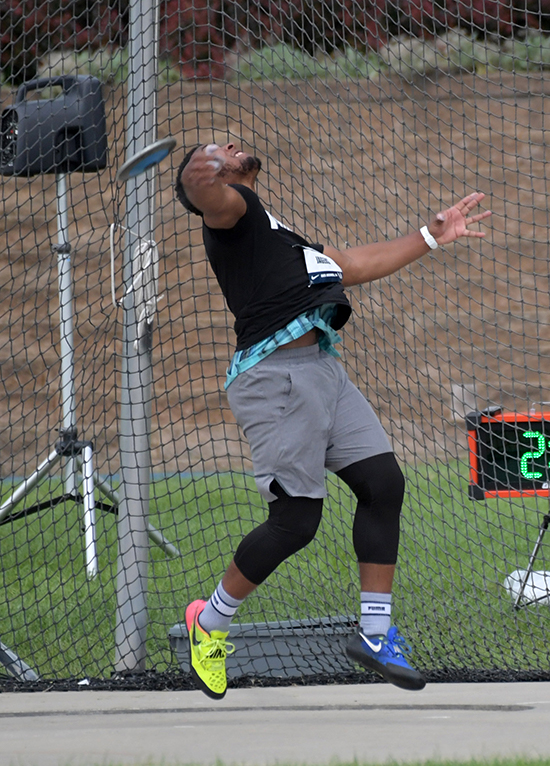
Another motivator for Jagers? His younger brother Phil, who threw for Akron. Born 364 days later, the right-hander with a best of 205-9 (62.71) placed 7th at USATF. “There’s a sibling rivalry there,” says Reggie. “We’ve been competing at things our whole lives.”
In Des Moines, “I remember I was heading out there because I was in the second flight. He was in the first flight, I hear that he’s in the lead of the competition. I’m really surprised, I’m like, ‘OK, Phillip, 61m, alright.’ It really got me going too because seeing that he was up there, I just wanted to go out there and back him up.”
In the end, winning the USATF title was huge for Jagers, especially after his ’17 experience finishing 7th with a strained groin muscle. “Five days before the U.S. championships. I’m out there on one leg. I was really disappointed because it took 199-8 (60.87) to make the World Championships team. I was disappointed that I wasn’t able to showcase that.
“I feel like your failures make you for the next year as well. So failing last year at the wrong time definitely made me hungry for this year to prove myself to people. People say it’s an off year, but I say it’s an off year if you don’t want to better yourself. Making these big teams, if you’re not the No. 1 guy, all the other guys feel like it’s an off year. So I made sure I was the No. 1 guy coming in.”
